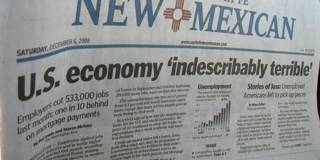Though official history portrayed the world's major central banks as embracing coordinated action to rescue the global financial system from disaster, the reality is that the Fed played the leading role. In fact, the Fed has effectively emerged from the crisis as the world’s central bank, while the IMF has been left on the sidelines.
PRINCETON – Balzac’s great novel Lost Illusions ends with an exposition of the difference between “official history,” which is “all lies,” and “secret history” – that is, the real story. It used to be possible to obscure history’s scandalous truths for a long time – even forever. Not anymore.
Nowhere is this more apparent than in accounts of the global financial crisis. The official history portrayed the US Federal Reserve, the European Central Bank, and other major central banks as embracing coordinated action to rescue the global financial system from disaster. But recently published transcripts of 2008 meetings of the Federal Open Market Committee, the Fed’s main decision-making body, reveal that the Fed has effectively emerged from the crisis as the world’s central bank, while continuing to serve primarily American interests.
The most significant meetings took place on September 16 and October 28 – in the aftermath of the collapse of the US investment bank Lehman Brothers – and focused on the creation of bilateral currency-swap agreements aimed at ensuring adequate liquidity. The Fed would extend dollar credits to a foreign bank in exchange for its currency, which the foreign bank agreed to buy back after a specified period at the same exchange rate, plus interest. This gave central banks – especially those in Europe, which faced a dollar shortage as US investors fled – the dollars they needed to lend to struggling domestic financial institutions.

PRINCETON – Balzac’s great novel Lost Illusions ends with an exposition of the difference between “official history,” which is “all lies,” and “secret history” – that is, the real story. It used to be possible to obscure history’s scandalous truths for a long time – even forever. Not anymore.
Nowhere is this more apparent than in accounts of the global financial crisis. The official history portrayed the US Federal Reserve, the European Central Bank, and other major central banks as embracing coordinated action to rescue the global financial system from disaster. But recently published transcripts of 2008 meetings of the Federal Open Market Committee, the Fed’s main decision-making body, reveal that the Fed has effectively emerged from the crisis as the world’s central bank, while continuing to serve primarily American interests.
The most significant meetings took place on September 16 and October 28 – in the aftermath of the collapse of the US investment bank Lehman Brothers – and focused on the creation of bilateral currency-swap agreements aimed at ensuring adequate liquidity. The Fed would extend dollar credits to a foreign bank in exchange for its currency, which the foreign bank agreed to buy back after a specified period at the same exchange rate, plus interest. This gave central banks – especially those in Europe, which faced a dollar shortage as US investors fled – the dollars they needed to lend to struggling domestic financial institutions.